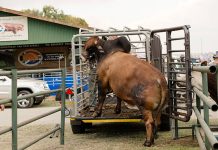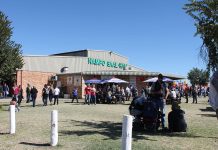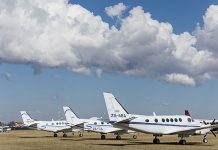Winners of the Best First Lactation Group at the 2008 Overberg Jersey Club Herd Competition, Caledon farmers Cyril Walker and his son John built an 800-head herd from nothing, taking mediocre results to award-winning level. Glenneis Erasmus learns how they did it.
Working at the telephone exchange at Caledon Post Office, Cyril Walker planted onions on leased land and dreamed of owning his own farm. Now, at the recent Overberg Jersey Club Herd Competition, he and his son John have won the award for the Best First Lactation Group. “Having a passion and being dedicated opens the doors of success, no matter the industry you’re in,” he says.
In 1979 Cyril had saved enough to buy 240ha just outside Greyton in the southern Cape. The region’s soil quality isn’t as good as the Overberg’s, but abundant good-quality water makes it ideal for dairy production. He continued planting onions for cash flow, but incorporated mixed Jersey cattle onto the farm, Ouplaas, as finances allowed. Over the years Ouplaas expanded to 900ha, of which 600ha is arable.
Cyril realised the best way to weather price fluctuations is to improve production efficiency.
“Instead of arguing with milk buyers, processors and retailers, or getting up in arms about things we have no control over, we focus on the things we can change, such as improving milk production volumes by getting rid of poor-performing animals and building our genetic base,” he says.
Building a management style
Cyril registered and started his Jersey stud, Cineraria, in 1991 when his son John returned from studying agriculture at the University of Stellenbosch. “I was confident his new-found knowledge would improve farm efficiency,” says Cyril.
The stud grew from 100 cows-in-milk to over 800 today. It allows for better selection and record-keeping and provides an alternative market, as most serious commercial farmers prefer buying stud animals with records. It was also decided to milk throughout the year, twice daily. “Seasonal production is obviously much easier to manage, but we feel continuous production uses labour and capital, such as milking machines and buildings optimally,” says Cyril. “Having irrigation also means we have enough fodder to do it.”
Breeding with the best
Cyril believes in using good-quality genetics. Three top bulls are kept on the farm. They are either put to heifers after artificial insemination (AI), or with older cows in fourth or fifth lactation which have difficulty conceiving with AI. The bulls are replaced yearly. Their daughters compare well to the progeny of imported semen being used, and are highly rated in BLUP analysis. They use the World Wide Sires reproduction programme which identifies and matches suitable breeding material. It matches cows with two or three suitable bulls, allowing farmers to achieve specific breeding goals. In 2002 the Cineraria herd was still performing below breed average for most traits on BLUP so, from 2003, they decided to invest in the best genetics.
Most of the AI semen is obtained from Canada and the US, costing up to R400/ straw. “If you buy cheap semen you’ll definitely lower your herd’s efficiency over the long term,” says Cyril. Heifers are artificially inseminated at 14 months and 240kg to 250kg. At lower weights there’s a danger they won’t have enough reserves to conceive successfully. Heifers are placed in small groups close to the shed to identify when they go on heat. Between 70% to 80% of heifers are artificially inseminated and the herd has an overall conception rate of 50% per straw with AI, which means an average of two straws per cow.
A 300-day lactation is maintained with a calving interval of around 400 days. Cows are inseminated as soon as they go into a positive growing phase, usually about 60 days to 90 days after calving. They’re automatically weighed daily in the Afikim milking system.
Improving through evaluation
The herd now has above-average scores in traits including milk volume, butterfat percentage and somatic cell count. Jersey South Africa visits the Walkers’ farm twice a year to score and evaluate the herd. “Our scores are definitely improving – our long-term investment in the herd is paying off and we’re on the right track,” says Cyril.
A rigorous culling programme removing cows producing less than 5 000â„“/ lactation improves average performance.
Importance of calf management
The Walkers see calf management as one of the most important contributors to farming success. To get the full benefit of immunity from colostrum, calves are retained with dams after birth and then for the first four days. From day one they get calf pellets formulated by Meadow Feeds for optimal nutrition and health. “Calves suffering setbacks usually struggle to catch up with the rest of the herd,” says John.
Calves are placed in calf pens where they get surrogate milk with calf pellets. They’re weaned at two months and placed in larger groups where they also receive hay. From the seventh month they’re placed on dryland lucerne.
Fed from the farm
Ouplaas has 90ha permanent clover and kikuyu pasture under irrigation. Maize is rotated with ryegrass for silage on 50ha. The rest of the pasture, 300ha, is under dryland lucerne and oats for hay and silage. Cyril says the long-term goal is to expand the stud to a size sustainable by the fodder on the farm. They will eventually buy nothing except dairy meal, to keep production costs as low as possible.
John planted apples on 32ha, prime land too far from the milking shed to be used for the herd. “Too much walking can reduce milk production,” he says. If pastures are in good condition the heifers get hay, otherwise an additional feed such as an apple-pulp/protein-feed mix is added. John says apple pulp is an excellent energy source and makes the feed mix taste better. There are three milking groups. The top group includes all cows from second lactation producing more than 27â„“/day. They’re on pastures in the morning and get silage and energy feed throughout the rest of the day.
Once milk production drops below 27â„“, a cow is moved to the second group, consisting of first- and second-lactation cows, or the third group of cows consisting of third lactation and older. These teams are on pasture all day and receive silage, and also graze at night if there’s a food surplus. The Afikim system determines how much feed cows get during milking according to their production, weight and lactation stage.
Maintaining animal health
Ensuring consistent animal health is important. To prevent foot rot and laminitis, cows receive a footbath of zinc once a week as they leave the milking shed, and formalin every second week. A fly dip is also sprayed to avoid diseases, especially eye infections. Milk samples are taken when mastitis occurs to identify the antibiotic needed. Milk is recorded every five weeks in accordance with the National Milk Recording Scheme to log butterfat, protein, milk urea nitrogen, lactose and somatic cell counts. Contact John Walker on (028) 254 9058 or e-mail [email protected]. |fw








